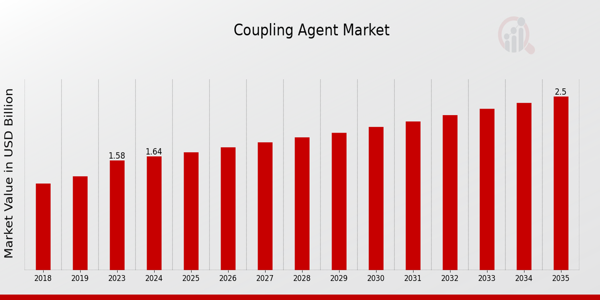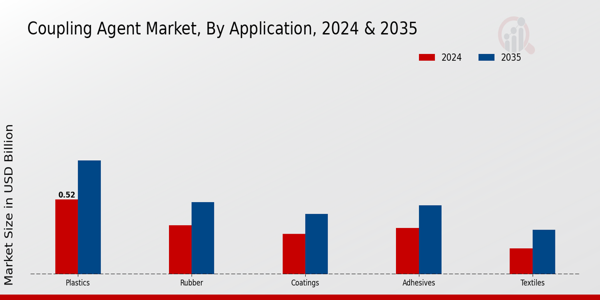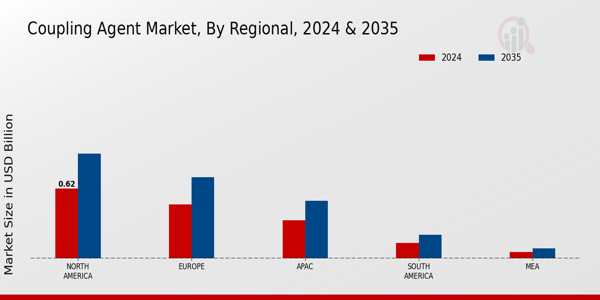Global Coupling Agent Market Overview
The Coupling Agent Market Size was estimated at 1.58 (USD Billion) in 2023.The Coupling Agent Industry is expected to grow from 1.64(USD Billion) in 2024 to 2.5 (USD Billion) by 2035. The Coupling Agent Market CAGR (growth rate) is expected to be around 3.93% during the forecast period (2025 - 2035).
Key Coupling Agent Market Trends Highlighted
The Global Coupling Agent Market is experiencing significant growth driven by the increasing demand for advanced materials in various industries, including automotive, construction, and packaging. The need for improved adhesion and compatibility among different substrates is propelling the adoption of coupling agents. Additionally, the rise of composite materials plays a crucial role as manufacturers seek to enhance material properties and performance. Environmental regulations are also influencing this growth, pushing companies to develop eco-friendly coupling agents that meet sustainability standards. Opportunities in the market include the development of innovative coupling agents tailored for specific applications, such as nanocomposites and bio-based products.
Companies are increasingly focusing on green chemistry and reducing the environmental impact of their products, leading to collaborations and innovations aimed at sustainability. As businesses recognize the importance of integrating eco-friendly practices, the demand for coupling agents that support these initiatives continues to rise. The cumulative effect of these trends suggests a vibrant and dynamic future for the Global Coupling Agent Market, with ample opportunities for growth and innovation.

Coupling Agent Market Drivers
Growing Demand for Advanced Materials
The Global Coupling Agent Market Industry is experiencing significant growth driven by the increasing demand for advanced composite materials across various industries. As new technologies and materials emerge, industries such as automotive, aerospace, and construction are seeking high-performance solutions that offer enhanced properties like strength, durability, and resistance to environmental factors. Coupling agents play a crucial role in these materials by improving the compatibility between different components, such as polymers and fillers or reinforcements, which leads to better performance in final products.As a result, more manufacturers are looking to incorporate coupling agents into their processes to meet stringent industry standards and consumer expectations. The rise of lightweight materials is particularly notable in the automotive sector as manufacturers strive to improve fuel efficiency and reduce emissions. This trend is prompting an increased focus on coupling agents that can enhance the properties of lightweight composites, thereby bolstering market growth.Similarly, the aerospace industry is investing in advanced materials that can withstand extreme conditions, further propelling the demand for effective coupling agents that enhance adhesion and material integrity. The construction sector is also evolving, with a growing preference for sustainable and resilient materials, which bolsters the requirement for coupling agents that optimize the performance of these materials. As the Global Coupling Agent Market Industry evolves, the shift toward green technologies and sustainable practices is expected to create fresh opportunities for innovation in coupling agents, underscoring their significance in the ongoing transformation of material science.
Expansion of the Automotive Industry
The expansion of the automotive industry is a major driver for the Global Coupling Agent Market Industry. As countries continue to invest in infrastructure and the automotive market evolves towards electric vehicles, there is an increasing requirement for lightweight and high-performance materials that enhance fuel efficiency and performance. Coupling agents are integral in formulating composite materials that meet these advanced specifications, thus accelerating their demand in the market.
Rising Environmental Regulations
Strict environmental regulations are pushing manufacturers towards more sustainable practices, influencing the Global Coupling Agent Market Industry significantly. Manufacturers are increasingly required to comply with regulations regarding emissions and material recycling. Coupling agents improve the performance of biodegradable or recyclable materials are set to gain traction as industries look for eco-friendly solutions without compromising performance.
Coupling Agent Market Segment Insights
Coupling Agent Market Application Insights
The Global Coupling Agent Market is steadily growing, with a significant emphasis on its application across various sectors, including Plastics, Rubber, Coatings, Adhesives, and Textiles. In 2024, the overall market is valued at 1.64 USD Billion, reflecting a robust demand for coupling agents which are essential for enhancing the performance and durability of materials. The segment focused on Plastics, valued at 0.52 USD Billion in 2024, stands out as a leading area due to the increasing consumption of plastic materials across industries such as packaging, automotive, and consumer goods. This segment is anticipated to experience notable growth as innovative plastic composites and high-performance materials continue to be developed. Similarly, the Rubber segment, valued at 0.34 USD Billion in 2024, is significant as coupling agents enhance bond strength and improve the overall mechanical properties of rubber-based products, which are extensively used in automotive tires and industrial applications. The Coatings segment, valued at 0.28 USD Billion in 2024, plays an important role in imparting better adhesion and weather resistance to paint and surface finishes, thus driving its relevance in the decorative and protective coatings sectors. On the other hand, the Adhesives sector, valued at 0.32 USD Billion in 2024, dominates due to the critical role that coupling agents play in improving adhesion performance for various substrates, thereby supporting the ever-increasing demand for bonding materials in construction and furniture industries. Furthermore, the Textiles sub-segment, with a lower market value of 0.18 USD Billion in 2024, is less dominant but still vital as it facilitates better dye uptake and enhances fabric properties, contributing to the growing demand for specialty textiles in fashion and upholstery. The projections for 2035 show notable growth across all applications, with Plastics anticipated to reach 0.79 USD Billion, reinforcing its majority holding, while Rubber, Coatings, and Adhesives also showcase considerable growth to 0.5 USD Billion, 0.42 USD Billion, and 0.48 USD Billion respectively. The overall positive market trends are supported by growing environmental concerns leading to advancements in bio-based coupling agents, alongside increasing application of coupling agents in high-performance products, which present significant opportunities in the Global Coupling Agent Market. As data shows consistent growth in these applications, the importance of coupling agents in enhancing material properties aligns well with the broader trends in sustainability and innovation in material science. The Global Coupling Agent Market statistics portray a landscape of evolving needs and opportunities driven by technology advancements and increasing product applications across multiple industries.

Coupling Agent Market Type Insights
The Global Coupling Agent Market is projected to grow significantly, with a market valuation reaching 1.64 billion USD in 2024. The market encompasses various types of coupling agents, including Silane, Titanate, and Zirconate, each playing a crucial role in enhancing the performance of materials. Silane Coupling Agents are notably important due to their wide applicability in industries such as construction and composites, where they improve adhesion and strength. Titanate Coupling Agents hold a significant position in the market as they promote compatibility between different materials, particularly in plastics, making them essential for various industrial applications.Zirconate Coupling Agents, while lesser-known, offer unique advantages in specialized applications, catering to niche markets needing specific functionalities. The Global Coupling Agent Market segmentation illustrates the diverse applications and growth potential across these types, which are driven by expanding industries such as automotive and construction. As noted in market growth statistics, the ongoing trends highlight a shift towards advanced materials and formulations, presenting opportunities for innovation within the industry.
Coupling Agent Market End Use Industry Insights
The Global Coupling Agent Market within the End Use Industry is projected to reach a valuation of 1.64 billion USD by 2024, reflecting its growing relevance across multiple sectors. Each industry demonstrates unique applications and demands for coupling agents, crucial for enhancing material compatibility and performance. In Automotive, for instance, the integration of coupling agents contributes to improving the durability and efficiency of materials used in vehicles. Construction relies on these agents for superior adhesive properties, promoting the longevity of building materials.Meanwhile, the Electronics sector benefits significantly, where coupling agents enable better conductivity and thermal stability in components. The Packaging industry also plays a vital role, as coupling agents enhance the barrier properties of materials, thereby improving product shelf life. The extensive utilization of coupling agents across these vital industries signifies their integral role in shaping market dynamics, driving growth opportunities, and presenting challenges related to material innovation and regulatory standards. Overall, the Global Coupling Agent Market data suggest a robust framework driven by demand in diverse end-use applications, promising sustained growth in the years ahead.
Coupling Agent Market Formulation Type Insights
The Global Coupling Agent Market is projected to reach a valuation of 1.64 billion USD by 2024, reflecting steady growth. Among the various formulation types, Single Component and Multi Component formulations play vital roles in providing flexibility and efficiency for diverse industrial applications. Liquid formulations are increasingly favored for their ease of application and compatibility, while Solid formulations are significant for providing robustness and stability in various environments. The market's segmentation reflects a balanced demand across these formulation types, with trends highlighting the growing preference for eco-friendly and high-performance solutions.Challenges such as fluctuating raw material prices may persist, yet the ongoing innovation in coupling agent technologies presents substantial opportunities for market players. As these dynamics evolve, the Global Coupling Agent Market data will continue to showcase the significance of each formulation type in meeting industry needs.
Coupling Agent Market Regional Insights
The Global Coupling Agent Market is experiencing notable growth across various regions, with North America leading the way. In 2024, North America achieved a market revenue of 0.62 USD Billion, which is expected to grow to 0.93 USD Billion by 2035, highlighting its majority holding in the market. Europe follows with a significant valuation of 0.48 USD Billion in 2024, anticipated to rise to 0.72 USD Billion in 2035. The APAC region, although smaller, has shown promise with a valuation of 0.34 USD Billion in 2024 and a projected ascent to 0.51 USD Billion in 2035, driven by industrial applications and growing manufacturing sectors.South America and MEA showcase lower valuations at 0.14 USD Billion and 0.06 USD Billion in 2024, respectively, with future projections of 0.21 USD Billion and 0.09 USD Billion by 2035. Despite their smaller market presence, these regions offer opportunities for growth due to increasing demand for coupling agents in various applications. The Global Coupling Agent Market segmentation highlights regional trends that indicate evolving demand, with each region's unique growth drivers contributing to the overall market landscape.

Coupling Agent Market Key Players and Competitive Insights
The Global Coupling Agent Market has become a focal point of intense competitive activity, with numerous players striving for dominance through innovation, strategic partnerships, and a keen understanding of market dynamics. Coupling agents are chemicals used to enhance the adhesion of dissimilar materials, thus playing a critical role in various applications such as plastics, rubber, and composites. A deep analysis of competitive insights reveals the strategies adopted by leading firms that emphasize advancements in technology and an expanded product portfolio tailored to meet the diverse needs of end-users. The market is characterized by the presence of established global players alongside emerging companies, each vying to secure a larger share amidst evolving consumer preferences and regulatory standards. Understanding the competitive landscape is crucial for companies aiming to innovate and differentiate their offerings in the rapidly growing coupling agent sector.Focusing on DuPont, this company has established a robust framework within the Global Coupling Agent Market due to its extensive research capabilities and history of high-performance chemical development. DuPont’s strengths lie in its commitment to innovation and sustainability, which resonate with contemporary market demands for eco-friendly solutions. The company has leveraged its advanced expertise in polymer science to develop a range of coupling agents that improve the compatibility and performance of composite materials. Moreover, DuPont's global reach and well-established supply chain enable it to effectively distribute its products across various regions, enhancing its competitive edge. The organization's focus on collaborations and partnerships allows for collective advancements within the industry, driving further market influence through shared technological expertise and resources.On the other hand, SABIC has carved a significant niche in the Global Coupling Agent Market by capitalizing on its extensive production capabilities and diverse portfolio. The company has maintained strong market presence due to its strategic investments in research and development aimed at enhancing the functional properties of its coupling agents. SABIC's strengths lie in its ability to offer customized solutions that address specific customer requirements, making its products particularly appealing to manufacturers seeking to optimize their production processes. Additionally, SABIC’s commitment to sustainability and efficiency has led to the development of environmentally friendly options that meet regulatory standards while still delivering high-performance results. This forward-thinking approach has allowed SABIC to not only retain its competitive position but also expand its influence in emerging markets, ensuring that it remains a relevant player in the evolving landscape of the coupling agent sector.
Key Companies in the Coupling Agent Market Include
- DuPont
- SABIC
- Evonik Industries
- ShinEtsu Chemical
- Kraton Corporation
- BASF
- 3M
- Rogers Corporation
- Wacker Chemie
- Dow Chemical
- Covestro
- Arkema
- Hexion
- Lanxess
- Momentive Performance Materials
Coupling Agent Market Industry Developments
Recent developments in the Global Coupling Agent Market have seen companies like DuPont and BASF investing heavily in innovation and sustainability initiatives. SABIC is focusing on expanding its product lines to adapt to changing market demands, while Evonik Industries has been enhancing its application technologies to address evolving customer needs. This sector has experienced significant growth in valuation, driven by increasing demand for performance materials across industries such as automotive, construction, and electronics.Mergers and acquisitions have also shaped the landscape; companies are strategically aligning through acquisitions to bolster their market position. For instance, Dow Chemical has been actively pursuing partnerships to expand its capabilities in coupling agents. In related news, 3M has announced several collaborations aimed at developing more efficient coupling solutions. Market dynamics indicate that Kraton Corporation's recent advancements in bio-based products may influence competitive strategies among other key players like ShinEtsu Chemical and Covestro. Overall, the emphasis on innovation and strategic mergers is anticipated to drive the market forward as companies seek to enhance their market presence and address the demand for high-performance coupling agents.
Coupling Agent Market Segmentation Insights
Coupling Agent Market Application Outlook
- Plastics
- Rubber
- Coatings
- Adhesives
- Textiles
Coupling Agent Market Type Outlook
- Silane Coupling Agents
- Titanate Coupling Agents
- Zirconate Coupling Agents
Coupling Agent Market End Use Industry Outlook
- Automotive
- Construction
- Electronics
- Packaging
Coupling Agent Market Formulation Type Outlook
- Single Component
- Multi Component
- Liquid
- Solid
Coupling Agent Market Regional Outlook
- North America
- Europe
- South America
- Asia Pacific
- Middle East and Africa
| Attribute/Metric Source: |
Details |
| MARKET SIZE 2023 |
1.58(USD Billion) |
| MARKET SIZE 2024 |
1.64(USD Billion) |
| MARKET SIZE 2035 |
2.5(USD Billion) |
| COMPOUND ANNUAL GROWTH RATE (CAGR) |
3.93% (2025 - 2035) |
| REPORT COVERAGE |
Revenue Forecast, Competitive Landscape, Growth Factors, and Trends |
| BASE YEAR |
2024 |
| MARKET FORECAST PERIOD |
2025 - 2035 |
| HISTORICAL DATA |
2019 - 2024 |
| MARKET FORECAST UNITS |
USD Billion |
| KEY COMPANIES PROFILED |
DuPont, SABIC, Evonik Industries, 3M, ShinEtsu Chemical, Kraton Corporation, BASF, Rogers Corporation, Wacker Chemie, Dow Chemical, Covestro, Arkema, Hexion, Lanxess, Momentive Performance Materials |
| SEGMENTS COVERED |
Application, Type, End Use Industry, Formulation Type, Regional |
| KEY MARKET OPPORTUNITIES |
Increasing demand in automotive sector, Growth in construction materials, Expanding electronics industry applications, Rising awareness of sustainability, Advancements in polymer technology |
| KEY MARKET DYNAMICS |
Growing demand from automotive industry, Increasing applications in electronics, Rise in sustainable packaging solutions, Advancements in polymer technology, Expanding construction and infrastructure sectors |
| COUNTRIES COVERED |
North America, Europe, APAC, South America, MEA |
Frequently Asked Questions (FAQ) :
The Global Coupling Agent Market is expected to be valued at 1.64 USD Billion in 2024.
The expected compound annual growth rate (CAGR) for the Global Coupling Agent Market from 2025 to 2035 is 3.93%.
In 2024, North America is expected to have the largest market share valued at 0.62 USD Billion.
The Coupling Agent Market in Europe is projected to be valued at 0.72 USD Billion by 2035.
The Plastics application segment is expected to grow the most, reaching a value of 0.79 USD Billion by 2035.
The market size for Rubber applications is anticipated to reach 0.5 USD Billion by 2035.
Major players in the Global Coupling Agent Market include DuPont, SABIC, Evonik Industries, and BASF.
The market value for Coatings applications in 2024 is expected to be 0.28 USD Billion.
The Textiles application segment is projected to grow to 0.31 USD Billion by 2035.
The anticipated market size for South America in 2024 is valued at 0.14 USD Billion.

















